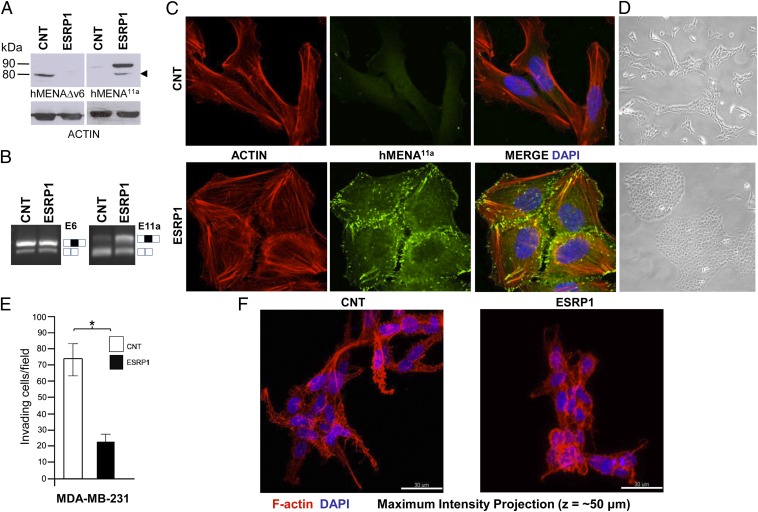Fig. 4.
Epithelial Splicing Regulatory Protein 1 (ESRP1) transduction induces hMENA11a expression in parallel with changes in cell shape and actin cytoskeleton architecture in MDA-MB-231 cells. (A) WB analysis of MDA-MB-231 cells transduced with the empty vector (CNT) or with ESRP1 (ESRP1), with the hMENA isoform-specific antibodies. hMENA11a is expressed only in the MDA-MB-231 ESRP1 cells. hMENA11a isoform-specific antibody also decorates a band compatible with the insertion of 21 aa of the exon 11a in the hMENAΔv6 isoform (arrowhead). (B) RT-PCR with RNA extracted from MDA-MB-231 cells transduced with the empty vector (CNT) or with ESRP1 (ESRP1), performed either with primers flanking exon 6 (Left), exon 6 inclusion = □■□; exon 6 skipping = □□, or with primers flanking the exon 11a (Right), exon 11a inclusion = □■□; 11a skipping = □□. PCR products were analyzed by agarose gel electrophoresis and ethidium bromide staining. E6, exon 6; E11a, exon 11a. (C) Confocal analysis of MDA-MB-231 cells transduced with the empty vector (CNT) or with ESRP1 using hMENA11a mAb (green) and phalloidin (red). Cells were imaged using a Zeiss 710 laser-scanning microscope. Magnification, 63×. (D) Phase-contrast images of MDA-MB-231 cells transduced with the empty vector or with ESRP1. (E) Matrigel invasion assays of MDA-MB-231 cells stably transduced with the empty vector (CNT) or ESRP1 (35,000 cells; 48 h of invasion). *P = 0.002. (F) Phalloidin staining of transduced cells grown in 3D lrECM culture.

